|
Palystes (rain spiders, lizard-eating spiders)
reënspinnekop, akkedisvretendespinnekop [Afrikaans]
Life
> Eukaryotes
>
Opisthokonta >
Metazoa
(animals) > Bilateria > Ecdysozoa > Panarthropoda > Tritocerebra >
Arthropoda > Arachnomorpha > Cheliceriformes > Chelicerata > Euchelicerata
> Arachnida > Araneae
> Araneomorpha > Family: Sparassidae (huntsman
spiders)
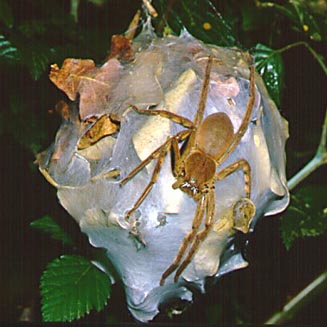 |
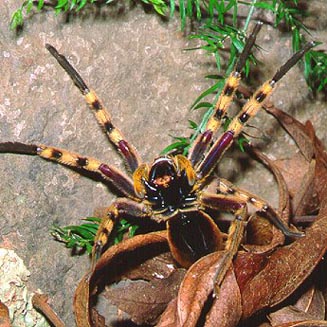 |
| Palystes castaneus on nest.
[image N. Larsen ©] |
Palystes castaneus in threat posture,
showing banding beneath the legs. [image N. Larsen
©] |
Palystes is derived from either the Latin
"palaestes" or Greek "palaistes" meaning wrestler. These are the large spiders,
often referred to as "tarantulas", that cause havoc by entering buildings during
summer or before rain.
These spiders were previously listed as potentially
dangerous. After tests where they were induced into biting guinea-pigs it was
established that although the guinea-pigs had died within 3 minutes, it had been
from shock and not the effects of any venom. For humans, the venom is in fact no
worse than a bee sting although the spider's aggressive display, with its 2
front pairs of banded legs raised in warning, is enough to shrink the stoutest
of hearts. They occur usually in vegetation but sometimes occur in the home.
Palystes occurs mainly on plants where it hunts
various insects but is also regularly found in the home where they are fond of
hunting geckos (usually the Marbled leaf-toed gecko,
Afrogecko porphyreus in
the Western Cape or the Cape dwarf gecko,
Lygodactylus capensis in the
eastern parts of southern Africa) and are sometimes called lizard-eating spiders. They usually appear in the home just before
the onset of rain and the males are regularly seen in August to December,
probably looking for females and also females busy foraging.
Palystes is also regularly seen in more unfortunate
circumstances where it is being dragged around by a wasp or often the wasp is
missing and all one finds is what seems to be a dead spider on the pathway. What
has in fact happened is that the spider has been stung and immobilized by a
female wasp of the family
Pompilidae. These wasps hunt only spiders that they sting and paralyse and
then stock each of their nests with a paralyzed spider, lay an egg on it and
then seal the nest. The wasp eggs then hatch and the larvae have live fresh food
on which to feed. All peripheral tissue is eaten first and lastly the vital
parts so the meal stays fresh long enough for the larva to mature and then
pupate.
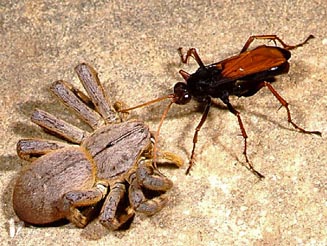 |
|
|
Pompilid wasp, Tachypompilus ignites,
dragging a paralysed Palystes superciliosus
spider to her nest. [image H. Robertson, Iziko
©]. |
|
Distribution
Twenty eight Palystes species occur in central, eastern and
southern Africa with 13 resident in South Africa.
Descriptions
Palystes body length is 15-36 mm with a leg span of up to
110 mm. Dorsally (top) it is covered in tan to dark tan velvety covering of setae
(hairs). The abdomen and legs might be interspersed with slightly longer setae
(hairs).
The diagnostic features are a white moustachial stripe
below the anterior (front) eyes and extending down the chelicerae (fangs) as
well as banding on the ventral (underside) of the legs.
Another identifying feature of Palystes castaneus and
P.
superciliosus, is the egg sac made by the female. It is a roundish bag made of
silk with leaves and twigs woven into it and is about 60-100mm in size. The
construction of this nursery and the laying of eggs takes about 3-5 hours. The
eggs hatch inside and are protected within the bag of silk and leaves. During
this time the female guards her brood aggressively. Many a gardener has been
bitten by a protective Palystes mother. After about 21 days, the spiderlings
chew their way out of the sac to join the world. These egg sacs are a common
sight from about November to April. Mating takes place in early summer and the
spider will produce about 3 egg cases in her 2 year life.
Species native to southern Africa
Palystes
ansiedippenaarae
Croeser,
1996
Palystes
ansiedippenaarae is
known from Modimolle (formerly Nylstroom in Limpopo), Warburton (Mpumalanga)
to Ndumo (Kwazulu-Natal). |
|
Palystes castaneus
(Latreille, 1819)
Palystes castaneus is
common from Cape Town to Heidelberg in the Western Cape. It appears to be
more common in forested areas and during November its egg cocoon is very
common in low vegetation and hedges. It is replaced by Palystes
superciliosus in
scrub outside forested areas. 17-22 mm. |
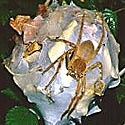 |
Palystes
crawshayi
Pocock, 1902
Palystes
crawshayi
is only known from
Lesotho. 17-26 mm. |
|
Palystes
johnstoni
Pocock,
1896
Palystes
johnstoni
is the common species
in Zimbabwe and Limpopo Province reaching into Malaŵi, Botswana (Okavango)
and Mozambique. It occurs in savannah woodland. |
|
Palystes
karooensis
Croeser, 1996
Palystes
karooensis
occurs mainly in the
mountainous areas of the Karoo. It occurs from Beaufort West (Western Cape)
to Graaf-Reinet to the Kleinwinterhoekberge and Kokstad district (Eastern
Cape). 14-22mm. |
|
Palystes kreutzmanni
Jäger & Kunz, 2010
Collected from near Kleinmond in the Western Cape, in fynbos. |
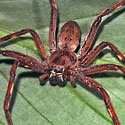 |
Palystes
leppanae
Pocock, 1902
Palystes
leppanae
occurs in the
Grahamstown to Alicedale areas of the Eastern Cape. 16-25mm. |
|
Palystes
leroyorum
Croeser, 1996
Palystes leroyorum
is found in the
Bloemfontein area (Free State) to Modimolle (formerly Nystroom in Limpopo). |
|
Palystes
lunatus
Pocock, 1896
Palystes
lunatus
is only known from the
type specimen. no locality is given only that it was collected in South
Africa. Croeser believes it may be a montane species from the Eastern Cape.
29mm. |
|
Palystes
martinfilmeri
Croeser, 1996
Palystes
martinfilmeri is less common, occurring in the Cedarberg-Piketberg area
(Northern and Western Cape). This is the largest species with a body length
of 19-36 mm. |
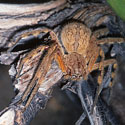 |
Palystes
perornatus
Pocock, 1900
Palystes
perornatus
is known from the Amatola and
Hogsbach Mountains (Eastern Cape) to Port Edward (Kwazulu-Natal). 23 mm. |
|
Palystes stilleri
Croeser, 1996
Palystes
stilleri occurs from
the Hottentots Holland Mountains, Stellenbosch district, to the Langerberg,
Grootvadersbosch
Heidelberg district, (Western
Cape). Possibly a forest species that often occurs in the same area as
Palystes
castaneus to which it is very similar. It can be separated from
P. castaneus
in that its egg cocoon is similar to a white ping-pong ball. The female
retreats into this with her eggs and cuts it open when she wants to leave.
26 mm. |
|
Palystes stuarti
Croeser, 1996
Palystes
stuarti only known from
Nieuwoudtville (Northern Cape). 24-34 mm. |
|
Palystes
superciliosus
L. Koch, 1875
Palystes
superciliosus is the
most common and widespread species of the genus and ranges from
Kwazulu-Natal westwards to Mpumalanga, North West, Limpopo, Eastern and
Western Cape. |
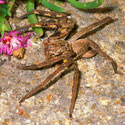 |
Publications (by date)
- Cayton-Boxall, P. 1988. The mating of two Palystes. Spider Club
News. 3 (1): 8.
- Croeser, P. M. C. 1979. Just a bag of old leaves? Eastern Cape
Naturalist 66: 8–10.
- Croeser, P. M. C. 1996. A revision of the African Huntsman spider
genus Palystes l. Kock, 1875 (Araneae:Heteropodidae). Annals of the Natal
Museum 37: 1-122.
- Dippenaar-Schoeman, A. S. & R. Jocqué. 1997. African Spiders: An
Identification Manual. Plant Protection Res. Inst. Handbook, no. 9,
Pretoria, 392 pp.
- Filmer, M. R., Revised Larsen, N. 2010. Filmer’s Spiders: An
Identification Guide for Southern Africa, Struik, Cape Town. 128pg
Jäger, Peter.1999. Sparassidae – the valid scientific name for the
huntsman spider (Arachnida: Araneae). Arachnol. Mitt. 17: 1-10.
- Jäger, P. 2000. Heteropoda parva n. sp. and H. martusa
n. sp. primitive or derived Heteropoda species? (Araneae:
Sparassidae: Heteropodinae). Mitt. internat. entomol. Ver. 25: 195-205.
- Jäger P, Kunz D. 2005: An illustrated key to genera of African
huntsman spiders (Araneae: Sparassidae). – Senckenbergiana biologica 85 (2):
163–213.
Download from here
- Jäger, P. & D. Kunz. Palystes kreutzmanni sp.n. - a new huntsman
spider species from fynbos vegetation in Western Cape Province, South Africa
(Araneae, Sparassidae, Palystinae). ZooKeys 67: 1-9.
- Larsen, N. 2005.More than just a bag of old leaves: A look into our Rain
Spiders. Newsletter of the Spider Club of South Africa 20 (2): 12
- Lawrence, R. F. (1952a). New spiders from the eastern half of South
Africa. Ann. Natal Mus. 12: 183-226.
- Lawrence, R. F. 1962. Spiders of the Namib desert. Ann. Transv. Mus. 24:
197-211.
- Lawrence, R. F. 1965. New and little known Arachnida from the Namib
desert, S.W. Africa. Scient. Pap. Namib Des. Res. Stn 27: 1-12.
- Lawrence, R. F. 1966. New dune spiders (Sparassidae) from the Namib
desert, South West Africa. Cimbebasia 217: 3-15.
- Warren, E.1926. On the habits, egg-sacs, oögenesis and early development
of the spider Palystes natalius (Karsh). Annals of the Natal Museum 5 (3):
303 – 349.
- Yates, J. H. 1968. Spiders of southern Africa. Cape Town: Books of
Africa. 6-73.
Unknown author.1998 The rain spider, the wasp and physiotherapy. Spider Club
News. 13 (3) : 5-6.
Text by Norman Larsen © |
